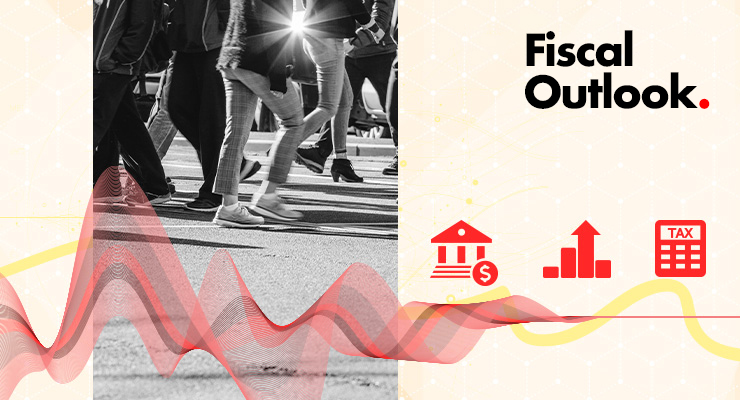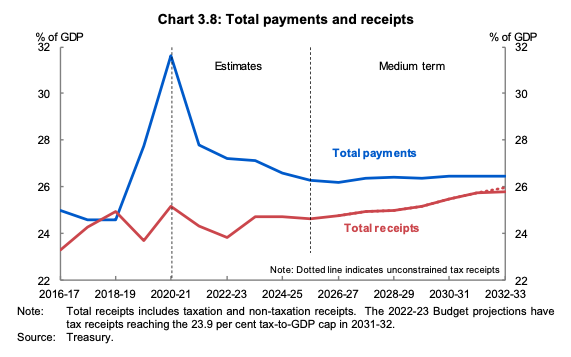
Aside from the politics of this desperate budget, there’s a longer-term story to tell about the growth of the size of government in Australia.
During the pandemic, and correctly, the government’s massive effort to save the economy took the size of government spending as a proportion of GDP to nearly one-third. In 2021-22 it was still nearly 28%. In more normal times, spending has been 24-25% of GDP.
But rather than snapping back to that pre-pandemic level, spending is forecast to remain stubbornly high — more than 27% in 2022-23 and 2023-24; more than 26% over the following two years. Spending is still forecast to be nearly $690 billion in 2026. When Malcolm Turnbull was prime minister, it was $450 billion.
If we want a government that routinely spends on us more than 26% of GDP, then we have to find revenue of a similar order of magnitude. But even in 2026, total government receipts — which includes both tax and other receipts — will be well below 25%. The government says, in any event, it won’t let tax receipts get above 23.9%, an arbitrarily selected level from the Howard years. And despite the Coalition’s high-taxing ways — it constantly taxes us at much higher levels than Labor ever did — we’ll still be well short of that benchmark even in 2026.
So, we have Howard-era tax levels and Morrison-era spending. They aren’t compatible, not over the long term. But that’s what we’re banking on: according to the budget papers, the deficit will still be 0.7% of GDP in 2032-33.

Send in the clowns
In 2022-23 we have the risible spectacle of Frydenberg speaking of “banking the dividend” of a stronger economy, while also borrowing $78 billion to spend on a bulging bag of bribes. The government got a taste for the power of fiscal stimulus during the pandemic and it is finding it hard to shake the habit.
The government’s excuse — apart from the increasingly laughable claim that its stimulus is “temporary” — is that deficits don’t really matter anymore. What matters is the size of government debt as a proportion of GDP. Net debt will now peak at 33.1% of GDP rather than 37% as predicted last year. We’ll outgrow our debt as the economy grows, sending the net debt-to-GDP ratio shrivelling.
It’s quite a change from a “Back In Black” mug.
And indeed, so long as global interest rates remain low, the debt load is cheap. The interest rates the Australian government is paying to borrow money are rising but still low by global standards. Also, thanks to rising inflation they are negative in inflation-adjusted terms.
But the treasurer must be watching global bond markets with a nervous eye, because the trajectory of interest rates is similar to the trajectory of petrol prices, and there is far less he can do about them.
It’s plain the government isn’t looking beyond election night in this budget. But whoever wins is going to have to resolve the clear tension between expenditure and taxation, and bring those spending and revenue lines a lot closer together a lot sooner than 2033.









Laying mines as someone commented.
Those which the Rodent & the Once & Future Smirk hid throughout the nation’s finances will be destroying equity for years to come unless removed.
These are more like damp squids on a hard road to ho-ho.
Heard on a TAI podcast that no other country’s economic narrative revolves around this “back in black”,surplus/deficit stuff like Australia’s does. I wonder who it serves? It certainly doesn’t serve anyone working in the two largest and growing employment sectors in the country- health and education, does it? It’s the reason they can’t get a wage rise, and if they can’t, nobody else can, either.